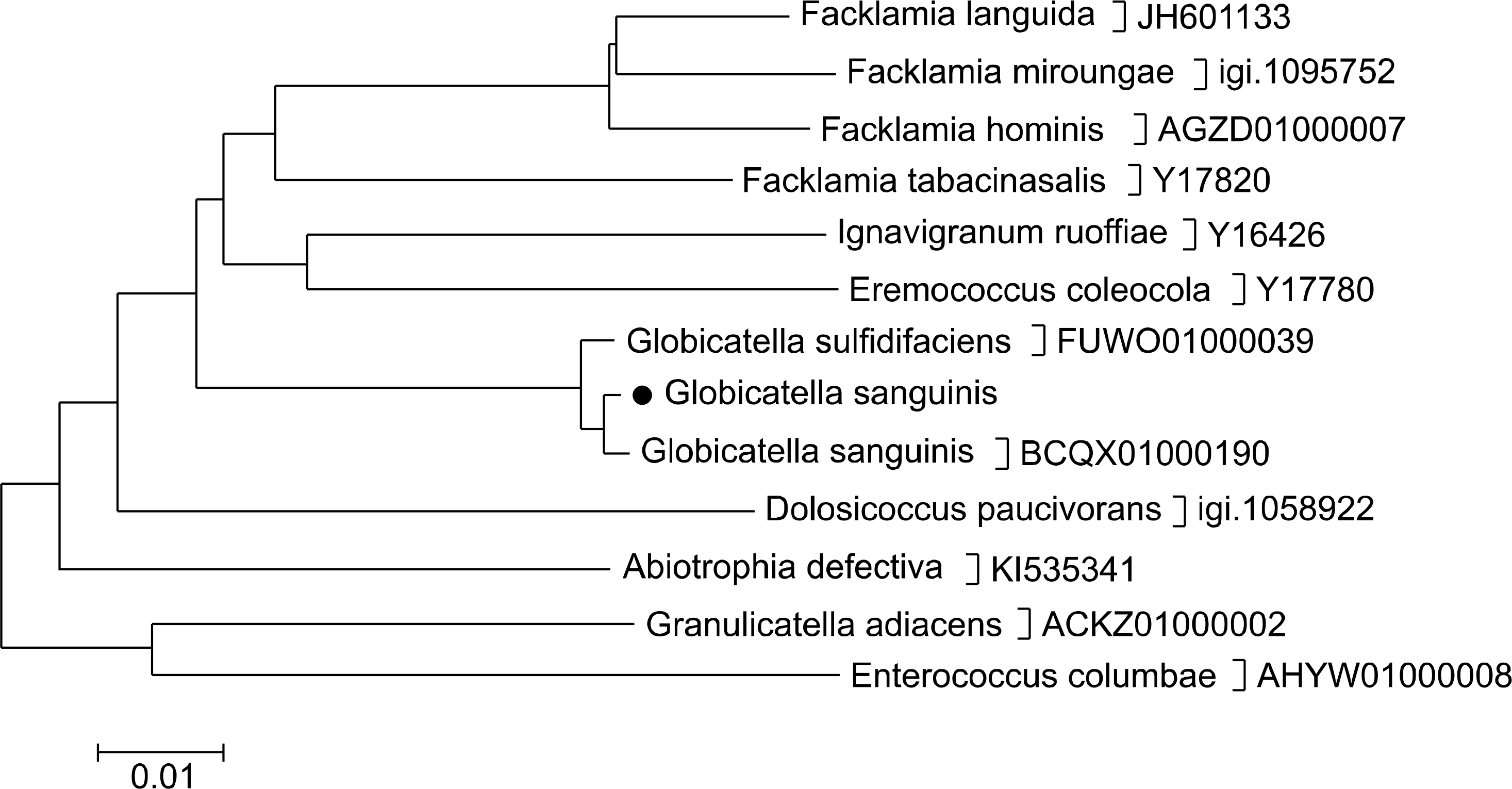Abstract
Globicatella sanguinis is an unusual pathogen causing bacteremia, meningitis, and urinary tract infection, and can be misidentified as Streptococcus pneumoniae or viridans streptococci due to its colonial morphology. A 76-year-old female patient with hypertension and degenerative arthritis was admitted to the hospital complaining of knee joint pain. Blood culture revealed the presence of Gram-positive cocci, and the isolated organism was equally identified as S. pneumoniae using the MicroScan identification system (Beckman Coulter, USA) and Vitek 2 identification system (bioMérieux, USA). However, the isolate showed optochin resistance based on the optochin disk susceptibility test. The organism was finally confirmed to be G. sanguinis based on 16S rRNA sequencing and hydrogen sulfide production testing. Accurate identification of G. sanguinis isolated from aseptic body fluids including blood is important for appropriate antibiotic selection based on accurate application of interpretative criteria of antimicrobial susceptibility test.
References
1. Collins MD, Aguirre M, Facklam RR, Shallcross J, Williams AM. Globicatella sanguis gen.nov., sp.nov., a new gram-positive catalase-negative bacterium from human sources. J Appl Bacteriol. 1992; 73:433–7.
2. Shewmaker PL, Steigerwalt AG, Shealey L, Weyant R, Facklam RR. DNA relatedness, phenotypic characteristics, and antimicrobial susceptibilities of Globicatella sanguinis strains. J Clin Microbiol. 2001; 39:4052–7.
3. Facklam R. What happened to the streptococci: overview of taxonomic and nomenclature changes. Clin Microbiol Rev. 2002; 15:613–30.

4. Vandamme P, Hommez J, Snauwaert C, Hoste B, Cleenwerck I, Lefebvre K, et al. Globicatella sulfidifaciens sp. nov., isolated from purulent infections in domestic animals. Int J Syst Evol Microbiol. 2001; 51:1745–9.

5. Takahashi S, Xu C, Sakai T, Fujii K, Nakamura M. Infective endocarditis following urinary tract infection caused by Globicatella sanguinis. IDCases. 2017; 11:18–21.

6. Yang HS, Kim YJ, Lee MS, Lee HJ. Globicatella sanguinis bacteremia in a non-immunocompromised patient identified by 16S rRNA gene sequencing: first case in Korea. Clin Lab. 2016; 62:1825–7.

7. CLSI. Performance standards for antimicrobial susceptibility testing. 27th ed.CLSI document M100.Wayne, PA: Clinical and Laboratory Standards Institute;2017.
8. CLSI. Interpretive criteria for identification of bacteria and fungi by DNA target sequencing; approved guideline. CLSI document MM18-A. Wayne, PA: Clinical and Laboratory Standards Institute;2008.
9. Lau SK, Woo PC, Li NK, Teng JL, Leung KW, Ng KH, et al. Globicatella bacteraemia identified by 16S ribosomal RNA gene sequencing. J Clin Pathol. 2006; 59:303–7.

10. Miller AO, Buckwalter SP, Henry MW, Wu F, Maloney KF, Abraham BK, et al. Globicatella sanguinis osteomyelitis and bacteremia: review of an emerging human pathogen with an expanding spectrum of disease. Open Forum Infect Dis. 2017; 4:ofw277.

11. Jain N, Mathur P, Misra MC. Globicatella sanguinis meningitis in a post head trauma patient: first case report from Asia. J Infect Dev Ctries. 2012; 6:592–4.

12. Héry-Arnaud G, Doloy A, Ansart S, Le Lay G, Le Flèche-Matéos A, Seizeur R, et al. Globicatella sanguinis meningitis associated with human carriage. J Clin Microbiol. 2010; 48:1491–3.
13. Seegmüller I, van der Linden M, Heeg C, Reinert RR. Globicatella sanguinis is an etiological agent of ventricul-operitoneal shunt-associated meningitis. J Clin Microbiol. 2007; 45:666–7.
14. Martínez JA, Horcajada JP, Almela M, Marco F, Soriano A, García E, et al. Addition of a macrolide to a beta-lactam-based empirical antibiotic regimen is associated with lower in-hospital mortality for patients with bacteremic pneumococcal pneumonia. Clin Infect Dis. 2003; 36:389–95.
Fig. 1.
Neighbor joining phylogenetic tree showing the relationship of our case to Globicatella species. The black dotted G. sanguinis is our isolate. Species name and accession code are given as cited in the EzBioCloud database.

Table 1.
Phenotypic characteristics of our isolate identified by commercial kits and Globicatella species previously reported




 PDF
PDF ePub
ePub Citation
Citation Print
Print


 XML Download
XML Download